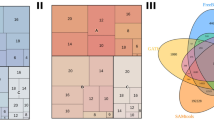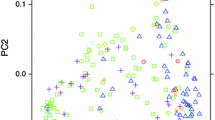Abstract
Key message
Marker-assisted selection is important for cultivar development. We propose a system where a training population genotyped for QTL and genome-wide markers may predict QTL haplotypes in early development germplasm.
Abstract
Breeders screen germplasm with molecular markers to identify and select individuals that have desirable haplotypes. The objective of this research was to investigate whether QTL haplotypes can be accurately predicted using SNPs derived by genotyping-by-sequencing (GBS). In the SunGrains program during 2020 (SG20) and 2021 (SG21), 1,536 and 2,352 lines submitted for GBS were genotyped with markers linked to the Fusarium head blight QTL: Qfhb.nc-1A, Qfhb.vt-1B, Fhb1, and Qfhb.nc-4A. In parallel, data were compiled from the 2011–2020 Southern Uniform Winter Wheat Scab Nursery (SUWWSN), which had been screened for the same QTL, sequenced via GBS, and phenotyped for: visual Fusarium severity rating (SEV), percent Fusarium damaged kernels (FDK), deoxynivalenol content (DON), plant height, and heading date. Three machine learning models were evaluated: random forest, k-nearest neighbors, and gradient boosting machine. Data were randomly partitioned into training–testing splits. The QTL haplotype and 100 most correlated GBS SNPs were used for training and tuning of each model. Trained machine learning models were used to predict QTL haplotypes in the testing partition of SG20, SG21, and the total SUWWSN. Mean disease ratings for the observed and predicted QTL haplotypes were compared in the SUWWSN. For all models trained using the SG20 and SG21, the observed Fhb1 haplotype estimated group means for SEV, FDK, DON, plant height, and heading date in the SUWWSN were not significantly different from any of the predicted Fhb1 calls. This indicated that machine learning may be utilized in breeding programs to accurately predict QTL haplotypes in earlier generations.





Similar content being viewed by others
Data availability
KASP and genotyping-by-sequencing data for SunGrains and genotyping-by-sequencing data for the Southern Uniform Winter Wheat Nursery lines are unavailable. Phenotypic data for the Southern Uniform Winter Wheat Scab Nursery are freely available at < scabusa.org > . Haplotype information related to resistance QTL used in the current study for the Southern Uniform Winter Wheat Nursery is freely available at < https://www.ars.usda.gov/southeast-area/raleigh-nc/plant-science-research/docs/small-grains-genotyping-laboratory/regional-nursery-marker-reports/ > .
Code availability
All code and raw output of code used in the current study may be found at < https://github.com/zjwinn/Profiling-of-FHB-Resistance-QTL-Haplotypes-Through-MM-GBG-and-ML > .
References
Alaux M, Rogers J, Letellier T, Flores R, Alfama F, Pommier C, International Wheat Genome Sequencing, C (2018) Linking the international wheat genome sequencing consortium bread wheat reference genome sequence to wheat genetic and phenomic data. Genome Biol 19(1): 111. https://doi.org/10.1186/s13059-018-1491-4
Appels R, Eversole K, Feuillet C, Keller B, Rogers J, Stein N, Poland J (2018) Shifting the limits in wheat research and breeding using a fully annotated reference genome. Science 361(6403):eaar7191
Arruda M, Lipka A, Brown P, Krill A, Thurber C, Brown-Guedira G, Kolb F (2016) Comparing genomic selection and marker-assisted selection for Fusarium head blight resistance in wheat (Triticum aestivum L.). Mol Breed 36(7):1–11
Belkasim S, Shridhar M, Ahmadi M (1992) Pattern classification using an efficient KNNR. Pattern Recogn 25(10):1269–1274
Breiman L (2001) Random forests. Mach Learn 45(1):5–32
Brown-Guedira G, Griffey C, Kolb F, McKendry A, Murphy J, Sanford D (2008) Breeding FHB-resistant soft winter wheat: progress and prospects. Cereal Res Commun 36(Supplement-6):31–35
Brown-Guedira G (2011) Cooperative uniform winter wheat scab nursery marker report. In: https://www.ars.usda.gov/southeast-area/raleigh-nc/plant-science-research/docs/small-grains-genotyping-laboratory/regional-nursery-marker-reports/cooperative-uniform-winter-wheat-scab-nurseries/: USDA-ARS
Brown-Guedira G (2012) Cooperative Uniform winter wheat scab nursery marker report. In: https://www.ars.usda.gov/southeast-area/raleigh-nc/plant-science-research/docs/small-grains-genotyping-laboratory/regional-nursery-marker-reports/cooperative-uniform-winter-wheat-scab-nurseries/: USDA-ARS
Brown-Guedira G (2013) Cooperative Uniform winter wheat scab nursery marker report. In: https://www.ars.usda.gov/southeast-area/raleigh-nc/plant-science-research/docs/small-grains-genotyping-laboratory/regional-nursery-marker-reports/cooperative-uniform-winter-wheat-scab-nurseries/: USDA-ARS
Brown-Guedira G (2014) Cooperative uniform winter wheat scab nursery marker report. In: https://www.ars.usda.gov/southeast-area/raleigh-nc/plant-science-research/docs/small-grains-genotyping-laboratory/regional-nursery-marker-reports/cooperative-uniform-winter-wheat-scab-nurseries/ USDA-ARS
Brown-Guedira G (2015) Cooperative uniform winter wheat scab nursery marker report. In: https://www.ars.usda.gov/southeast-area/raleigh-nc/plant-science-research/docs/small-grains-genotyping-laboratory/regional-nursery-marker-reports/cooperative-uniform-winter-wheat-scab-nurseries/: USDA-ARS
Brown-Guedira G (2016) Cooperative uniform winter wheat scab nursery marker report. In: https://www.ars.usda.gov/southeast-area/raleigh-nc/plant-science-research/docs/small-grains-genotyping-laboratory/regional-nursery-marker-reports/cooperative-uniform-winter-wheat-scab-nurseries/: USDA-ARS
Brown-Guedira G (2017) Cooperative uniform winter wheat scab nursery marker report. In: https://www.ars.usda.gov/southeast-area/raleigh-nc/plant-science-research/docs/small-grains-genotyping-laboratory/regional-nursery-marker-reports/cooperative-uniform-winter-wheat-scab-nurseries/: USDA-ARS
Brown-Guedira G (2018) Cooperative uniform winter wheat scab nursery marker report. In: https://www.ars.usda.gov/southeast-area/raleigh-nc/plant-science-research/docs/small-grains-genotyping-laboratory/regional-nursery-marker-reports/cooperative-uniform-winter-wheat-scab-nurseries/: USDA-ARS
Brown-Guedira G (2019) Cooperative uniform winter wheat scab nursery marker report. In: https://www.ars.usda.gov/southeast-area/raleigh-nc/plant-science-research/docs/small-grains-genotyping-laboratory/regional-nursery-marker-reports/cooperative-uniform-winter-wheat-scab-nurseries/: USDA-ARS
Browning SR, Browning BL (2007) Rapid and accurate haplotype phasing and missing-data inference for whole-genome association studies by use of localized haplotype clustering. Am J Hum Genet 81(5):1084–1097
Browning BL, Zhou Y, Browning SR (2018) A one-penny imputed genome from next-generation reference panels. Am J Hum Genet 103(3):338–348. https://doi.org/10.1016/j.ajhg.2018.07.015
Browning BL, Tian X, Zhou Y, Browning SR (2021) Fast two-stage phasing of large-scale sequence data. Am J Hum Genet 108(10):1880–1890. https://doi.org/10.1016/j.ajhg.2021.08.005
Buerstmayr M, Steiner B, Buerstmayr H (2020) Breeding for Fusarium head blight resistance in wheat—progress and challenges. Plant Breed 139(3):429–454
Butler D, Cullis BR, Gilmour A, Gogel B (2009) ASReml-R reference manual. The State of Queensland, Department of Primary Industries and Fisheries, Brisbane
Carpenter NR, Wright E, Malla S, Singh L, Van Sanford D, Clark A, Chao S (2020) Identification and validation of Fusarium head blight resistance QTL in the US soft red winter wheat cultivar ‘Jamestown.’ Crop Sci 60(6):2919–2930
Cuthbert PA, Somers DJ, Thomas J, Cloutier S, Brulé-Babel A (2006) Fine mapping Fhb1, a major gene controlling fusarium head blight resistance in bread wheat (Triticum aestivum L). Theor Appl Genet 112(8):1465
Danecek P, Auton A, Abecasis G, Albers CA, Banks E, DePristo MA, Genomes Project Analysis, G (2011) The variant call format and VCFtools. Bioinformatics 27(15): 2156-2158. https://doi.org/10.1093/bioinformatics/btr330
Friedman JH (2001) Greedy function approximation: a gradient boosting machine. Ann Stat 29:1189–1232
Glaubitz JC, Casstevens TM, Lu F, Harriman J, Elshire RJ, Sun Q, Buckler ES (2014) TASSEL-GBS: a high capacity genotyping by sequencing analysis pipeline. PLoS ONE 9(2):e90346
National Grain and Feed Association (2011) FDA mycotoxin regulatory guidance. In: A guide for gain elevators, feed manufacturers, grain processors and exporters. National Grain and Feed Association, p 7
Gutierrez-Gonzalez JJ, Mascher M, Poland J, Muehlbauer GJ (2019) Dense genotyping-by-sequencing linkage maps of two synthetic W7984×Opata reference populations provide insights into wheat structural diversity. Sci Rep 9(1):1793. https://doi.org/10.1038/s41598-018-38111-3
He C, Holme J, Anthony J (2014) SNP genotyping: the KASP assay. In: Walker JM (ed) Crop breeding. School of Life Sciences, University of Hertfordshire, Hatfield, pp 75–86
Kuhn M (2008) Building predictive models in R using the caret package. J Stat Softw 28(1):1–26
Li H, Durbin R (2009) Fast and accurate short read alignment with Burrows-Wheeler transform. Bioinformatics 25(14):1754–1760. https://doi.org/10.1093/bioinformatics/btp324
Lundberg DS, Yourstone S, Mieczkowski P, Jones CD, Dangl JL (2013) Practical innovations for high-throughput amplicon sequencing. Nat Methods 10(10):999–1002
McHugh ML (2012) Interrater reliability: the kappa statistic. Biochemia Medica 22(3):276–282
McMullen M, Bergstrom G, De Wolf E, Dill-Macky R, Hershman D, Shaner G, Van Sanford D (2012) A unified effort to fight an enemy of wheat and barley: Fusarium head blight. Plant Dis 96(12):1712–1728
Moose SP, Mumm RH (2008) Molecular plant breeding as the foundation for 21st century crop improvement. Plant Physiol 147(3):969–977
Murphy J, Navarro R (2010) Southern uniform winter wheat scab nursery. In: https://scabusa.org/db/documents.php: U.S. Wheat and Barley Scab Initiative
Murphy J, Navarro R (2011) Southern uniform winter wheat scab nursery. In: https://scabusa.org/pdfs_dbupload/suwwsn11_report.pdf: U.S. Wheat and Barley Scab Initiative
Murphy J, Navarro R (2012) Southern uniform winter wheat scab nursery. In: https://scabusa.org/pdfs_dbupload/suwwsn12_report.pdf: U.S. Wheat and Barley Scab Initiative
Murphy J, Navarro R (2013) Southern uniform winter wheat scab nursery. In: https://scabusa.org/pdfs_dbupload/suwwsn13_report.pdf: U.S. Wheat and Barley Scab Initiative
Murphy J, Navarro R (2014) Southern uniform winter wheat scab nursery. In: https://scabusa.org/pdfs_dbupload/suwwsn14_report.pdf: U.S. Wheat and Barley Scab Initiative
Murphy J, Lyerly J, Petersen S, Poole B (2015) Southern uniform winter wheat scab nursery. In: https://scabusa.org/pdfs_dbupload/suwwsn15_report.pdf: U.S. Wheat and Barley Scab Initiative
Murphy J, Lyerly J, Sarinelli J, Tyagi P, Brown-Guedira G (2016) Southern uniform winter wheat scab nursery. In: https://scabusa.org/pdfs_dbupload/suwwsn16_report.pdf: U.S. Wheat and Barley Scab Initiative
Murphy J, Lyerly J, Acharya R, Sarinelli J, Tyagi P, Page J, Brown-Guedira G (2017) Southern uniform winter wheat scab nursery. In: https://scabusa.org/pdfs_dbupload/suwwsn17_report.pdf: U.S. Wheat and Barley Scab Initiative
Murphy J, Lyerly J, Acharya R, Page J, Ward B, Brown-Guedira G (2018) Southern uniform winter wheat scab nursery. In. https://scabusa.org/pdfs_dbupload/suwwsn18_report.pdf: U.S. Wheat and Barley Scab Initiative
Murphy J, Lyerly J, Acharya R, Page J, Ward B, Brown-Guedira G (2019) Southern uniform winter wheat scab nursery. In: https://scabusa.org/pdfs_dbupload/suwwsn19_report.pdf: U.S. Wheat and Barley Scab Initiative
Murphy J, Lyerly J, Winn Z, Page J, Brown-Guedira G (2020) Southern uniform winter wheat scab nursery. In: https://scabusa.org/pdfs_dbupload/suwwsn20_report.pdf: U.S. Wheat and Barley Scab Initiative
Perdry H, Dandine-Roulland L (2018) Gaston—genetic data handling (QC, GRM, LD, PCA) & linear mixed Models. R Package 83:1–29
Petersen S, Lyerly JH, Maloney PV, Brown-Guedira G, Cowger C, Costa JM, Murphy JP (2016) Mapping of Fusarium head blight resistance quantitative trait loci in winter wheat cultivar NC-Neuse. Crop Sci 56(4):1473–1483
Petersen S, Lyerly JH, McKendry AL, Islam MS, Brown-Guedira G, Cowger C, Murphy JP (2017) Validation of Fusarium head blight resistance QTL in US winter wheat. Crop Sci 57(1):1–12
Poland JA, Brown PJ, Sorrells ME, Jannink J-L (2012) Development of high-density genetic maps for barley and wheat using a novel two-enzyme genotyping-by-sequencing approach. PLoS ONE 7(2):e32253
R Core Team (2013) R: A language and environment for statistical computing
Rhoads A, Au KF (2015) PacBio sequencing and its applications. Genomics Proteomics Bioinform 13(5):278–289
Sarinelli JM, Murphy JP, Tyagi P, Holland JB, Johnson JW, Mergoum M, Sutton R (2019) Training population selection and use of fixed effects to optimize genomic predictions in a historical USA winter wheat panel. Theor Appl Genet 132(4):1247–1261
Su Z, Bernardo A, Tian B, Chen H, Wang S, Ma H, Li T (2019) A deletion mutation in TaHRC confers Fhb1 resistance to Fusarium head blight in wheat. Nat Genet 51(7):1099–1105
Waldron B, Moreno-Sevilla B, Anderson J, Stack R, Frohberg R (1999) RFLP mapping of QTL for Fusarium head blight resistance in wheat. Crop Sci 39(3):805–811
Ward TJ, Clear RM, Rooney AP, O’Donnell K, Gaba D, Patrick S, Nowicki TW (2008) An adaptive evolutionary shift in Fusarium head blight pathogen populations is driving the rapid spread of more toxigenic Fusarium graminearum in North America. Fungal Genet Biol 45(4):473–484. https://doi.org/10.1016/j.fgb.2007.10.003
Wright EE (2014) Identification of Native FHB Resistance QTL in the SRW Wheat Cultivar Jamestown, Virginia Tech
Funding
The research conducted in this study was directly supported by funds from the North Carolina Small Grains Growers Association and indirectly through the United States Wheat and Barley Scab Initiative (USWBSI) over time in phenotypic evaluation of the SUWWSN and genotyping of lines in the SG20, SG21, and SUWWSN panels.
Author information
Authors and Affiliations
Contributions
J.L. and Z.J.W. were responsible for conceptualization and methodology; Z.J.W. contributed to software, validation, writing and preparing the original draft, and visualization; Z.J.W. and B.W. carried out the formal analysis; J.L., Z.J.W., and B.W. conducted investigation; Z.J.W., J.L., G.B.G., R.E.B., M.M., J.J., S.H., A.B., R.E.M., R.S., and J.P.M. performed data curation; Z.J.W., J.L., B.W., G.B.G., R.E.B., M.M., J.J., S.H., A.B., R.E.M., R.S., and J.P.M. wrote, reviewed, and edited the manuscript; J.P.M., G.B.G., and J.L. supervised the study; J.P.M. was involved in project administration; and J.P.M. and G.B.G. acquired the funding.
Corresponding author
Ethics declarations
Conflict of interest
The author claims no conflict of interest.
Additional information
Communicated by Jochen Reif.
Publisher's Note
Springer Nature remains neutral with regard to jurisdictional claims in published maps and institutional affiliations.
Supplementary Information
Below is the link to the electronic supplementary material.
Rights and permissions
About this article
Cite this article
Winn, Z.J., Lyerly, J., Ward, B. et al. Profiling of Fusarium head blight resistance QTL haplotypes through molecular markers, genotyping-by-sequencing, and machine learning. Theor Appl Genet 135, 3177–3194 (2022). https://doi.org/10.1007/s00122-022-04178-w
Received:
Accepted:
Published:
Issue Date:
DOI: https://doi.org/10.1007/s00122-022-04178-w




